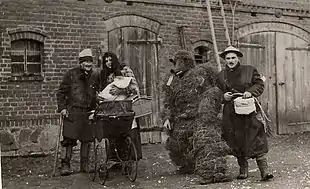
Leading the bear (Silesian: Wodzynie bera) is a Slavic carnival tradition. It enjoyed brief popularity in the entire Slavic region,[1] the practice still takes place in the areas of Upper Silesia, especially in the Opole Voivodeship.
A colorful procession of disguised people goes from house to house through the village, leading on a bear's rope. The bear (Teddy bear, ber) is tied in pea or straw ropes braided into plaits, on its head it has a tall straw hat with a bell. Another variation of the outfit was a set consisting of a sheepskin coat turned with the hair on top and a fur hat on the head.[2] The typical composition of the retinue is: a young couple, a chimney sweep, a doctor, a forester, a devil, a priest, a chemist, a gypsy girl, a camel (camel), a policeman, a butcher, musicians (accordion, drum), bridesmaids and groomsmen, a thief, a newsboy.[3]
One of the first to mention about leading a bear was Józef Lompa in 1842. He supposes that this custom dates back to the fourteenth or fifteenth century, when in Silesia you could still meet bears, sometimes wreaking havoc in peasant farms. Currently, when the procession is approaching the house, its members are trying to buy themselves from misfortunes with money, sweets or alcohol. In the past, they bought eggs, gingerbread or flour. The leading of the bear takes place most often on the penultimate Saturday of the carnival.[1]
In the Eastern Slavic region
In Russia and Ukraine, during New Year's Eve, processions with a dressed-up bear and a goat pass through the villages. In the old days, there were frequent processions with a live human-led bear as well as the Bear Dance in the group of the so-called skoromokhov. Dishes are prepared for the bear, such as mamaliga or pierogi, to bribe it so that it does not damage people's property. The bear is also invited to dinner at Maslenitsa.[1]
In the South Slavic region
In January, at Saint Sebastian on 14 January, in Serbia and Bulgaria, to protect the bear against the bear's hunt, it is given boiled corn overnight, i.e. mamaliga, corn grains or bread.[1]
References
- 1 2 3 4 Gieysztor, Aleksander (2006). Pieniądz, Aneta (ed.). Mitologia Słowian. doi:10.31338/uw.9788323525486. ISBN 9788323525486.
- ↑ Nowaczyk, Marta (2016), "Średniowieczne wierzenia – nieczysta siła w kulturze Słowian", Varia Mediaevalia. Studia nad średniowieczem w 1050. rocznicę Chrztu Polski, Wydawnictwo UŁ, doi:10.18778/8088-325-3.20, ISBN 978-83-8088-325-3, retrieved 5 January 2021
- ↑ "Archiwum Państwowe w Opolu / Staatsarchiv Oppeln (Opole)", Ehemalige preußische Provinz Schlesien, Berlin, Boston: DE GRUYTER SAUR, pp. 314–370, 2005, doi:10.1515/9783110961546.314, ISBN 978-3-11-096154-6, retrieved 5 January 2021